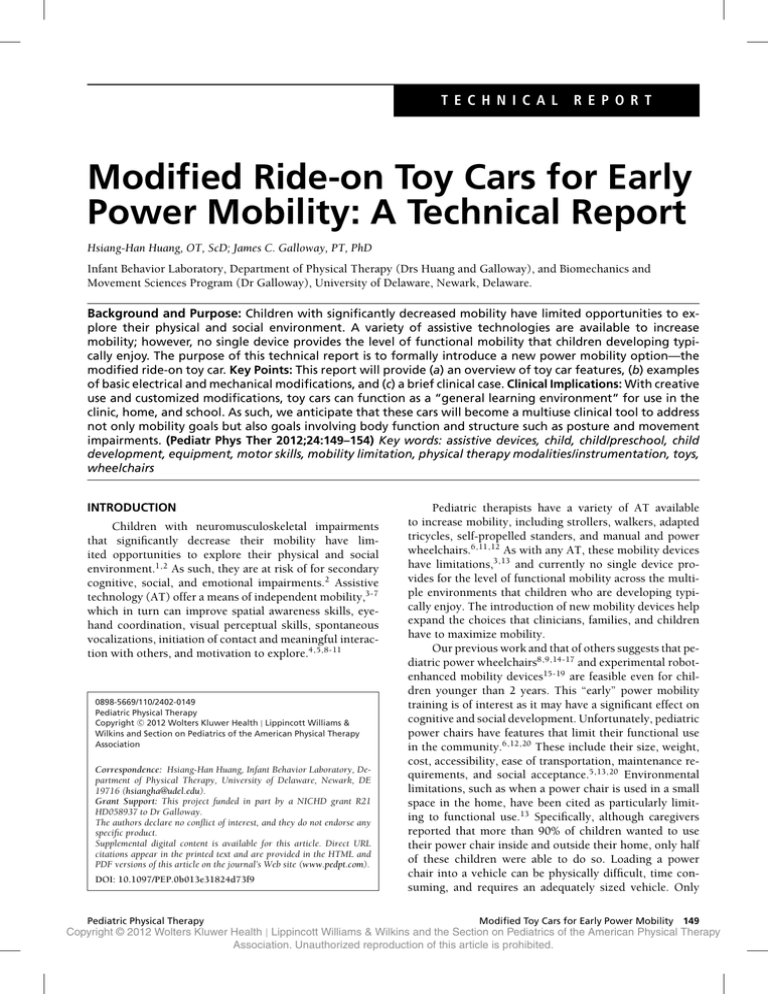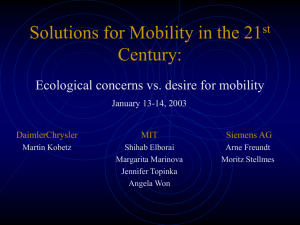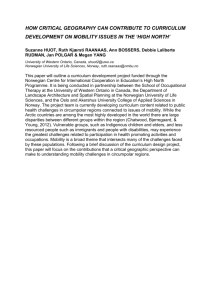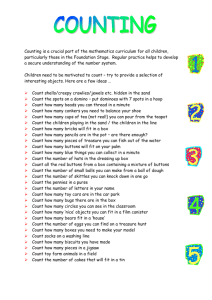Modified Ride-on Toy Cars for Early Power Mobility: A Technical Report
advertisement

T E C H N I C A L R E P O R T Modified Ride-on Toy Cars for Early Power Mobility: A Technical Report Hsiang-Han Huang, OT, ScD; James C. Galloway, PT, PhD Infant Behavior Laboratory, Department of Physical Therapy (Drs Huang and Galloway), and Biomechanics and Movement Sciences Program (Dr Galloway), University of Delaware, Newark, Delaware. Background and Purpose: Children with significantly decreased mobility have limited opportunities to explore their physical and social environment. A variety of assistive technologies are available to increase mobility; however, no single device provides the level of functional mobility that children developing typically enjoy. The purpose of this technical report is to formally introduce a new power mobility option—the modified ride-on toy car. Key Points: This report will provide (a) an overview of toy car features, (b) examples of basic electrical and mechanical modifications, and (c) a brief clinical case. Clinical Implications: With creative use and customized modifications, toy cars can function as a “general learning environment” for use in the clinic, home, and school. As such, we anticipate that these cars will become a multiuse clinical tool to address not only mobility goals but also goals involving body function and structure such as posture and movement impairments. (Pediatr Phys Ther 2012;24:149–154) Key words: assistive devices, child, child/preschool, child development, equipment, motor skills, mobility limitation, physical therapy modalities/instrumentation, toys, wheelchairs INTRODUCTION Children with neuromusculoskeletal impairments that significantly decrease their mobility have limited opportunities to explore their physical and social environment.1,2 As such, they are at risk of for secondary cognitive, social, and emotional impairments.2 Assistive technology (AT) offer a means of independent mobility,3-7 which in turn can improve spatial awareness skills, eyehand coordination, visual perceptual skills, spontaneous vocalizations, initiation of contact and meaningful interaction with others, and motivation to explore.4,5,8-11 0898-5669/110/2402-0149 Pediatric Physical Therapy C 2012 Wolters Kluwer Health | Lippincott Williams & Copyright Wilkins and Section on Pediatrics of the American Physical Therapy Association Correspondence: Hsiang-Han Huang, Infant Behavior Laboratory, Department of Physical Therapy, University of Delaware, Newark, DE 19716 (hsiangha@udel.edu). Grant Support: This project funded in part by a NICHD grant R21 HD058937 to Dr Galloway. The authors declare no conflict of interest, and they do not endorse any specific product. Supplemental digital content is available for this article. Direct URL citations appear in the printed text and are provided in the HTML and PDF versions of this article on the journal’s Web site (www.pedpt.com). DOI: 10.1097/PEP.0b013e31824d73f9 Pediatric Physical Therapy Pediatric therapists have a variety of AT available to increase mobility, including strollers, walkers, adapted tricycles, self-propelled standers, and manual and power wheelchairs.6,11,12 As with any AT, these mobility devices have limitations,3,13 and currently no single device provides for the level of functional mobility across the multiple environments that children who are developing typically enjoy. The introduction of new mobility devices help expand the choices that clinicians, families, and children have to maximize mobility. Our previous work and that of others suggests that pediatric power wheelchairs8,9,14-17 and experimental robotenhanced mobility devices15-19 are feasible even for children younger than 2 years. This “early” power mobility training is of interest as it may have a significant effect on cognitive and social development. Unfortunately, pediatric power chairs have features that limit their functional use in the community.6,12,20 These include their size, weight, cost, accessibility, ease of transportation, maintenance requirements, and social acceptance.5,13,20 Environmental limitations, such as when a power chair is used in a small space in the home, have been cited as particularly limiting to functional use.13 Specifically, although caregivers reported that more than 90% of children wanted to use their power chair inside and outside their home, only half of these children were able to do so. Loading a power chair into a vehicle can be physically difficult, time consuming, and requires an adequately sized vehicle. Only Modified Toy Cars for Early Power Mobility 149 Copyright © 2012 Wolters Kluwer Health | Lippincott Williams & Wilkins and the Section on Pediatrics of the American Physical Therapy Association. Unauthorized reproduction of this article is prohibited. 57% of 35 caregivers13 had a van for transportation. Experimental mobility devices have the potential to address some of these limitations such as size, weight, and cost but are likely years from commercial availability. It is critical to identify AT that is available at this time for use by children and their families to address activity and participation goals. The purpose of this technical report is to formally introduce a new option for early power mobility—the rideon toy car. This report will provide (a) an overview of toy car features, (b) examples of basic electrical and mechanical modifications to seating, steering systems, and drive systems, and (c) a brief clinical case. RIDE-ON TOY CARS: GENERAL FEATURES The Table briefly summarizes the basic features of toy cars. Four features are of particular interest: cost, accessibility, aesthetics, and adjustability. First, toy cars cost less than $400 and often less than $200, which is comparable to or less than most mobility devices. Second, most are relatively lightweight, small, and often can be easily transported unlike power chairs. Third, the child-friendly, colorful toy designs and the various toy functions (eg, headlights, radio, car noise) likely make these cars more acceptable to adults and children than some other mobility devices. This may be an important aspect for clinicians wanting to start early power mobility training with families hesitant to discuss power chair options. Fourth, a toy car is not a complex electromechanical device and, as outlined in the following texts, can be modified quickly and easily with a range of customized accessories that match the child’s changing capabilities and family goals. RIDE-ON TOY CARS: MODIFICATIONS Toy cars will likely require electrical and/or mechanical modifications for use with children with mobility impairments.21 Two interesting aspects of modifying these cars are (1) modifications can be constructed to be permanent (ie, relatively fixed) or temporary (ie, interchangeable), and (2) with creative design and planning, clinicians can construct a range of custom modifications to address goals reflecting 1 or more of the International Classification of Functioning, Disability and Health (ICF) components22 while the child and family focus on fun. Initially, a decision must be made regarding which of the various car types and sizes fit a child’s current and/or future body size and capabilities (Figure 1). Cars can be purchased from most major stores selling toys or ordered online from distributors worldwide. Each toy car has an original design with features that inherently fit certain children. Thus, the type and degree of modification of that original design becomes child- and goal-specific. For example, the original design of a Fisher Price Lightening McQueenTM (Fisher-Price Headquarters, East Aurora, New York) may fit a taller or larger child than a Fisher Price MaterTM (Fisher-Price Headquarters), given the greater leg room. The McQueenTM , however, may require more seating modifications for children with less trunk control than MaterTM (Figure 1A and B). The original design of a Fisher Price Thomas TrainTM (Fisher-Price Headquarters) may fit a child with small body size and good trunk control given its small seat size and minimal seat supports (Figure 1C and D). Two-seat cars (Fisher-Price Headquarters) can also be used if a child has a larger body size, wants to drive with siblings and peers, or needs a place for additional equipment such as a ventilator (1E and F). Next, we introduce a few basic modifications involving (a) seating, (b) steering systems, and (c) the drive system. These modification examples were specifically chosen as they are simple, low cost, and appropriate for clinicians and/or families to undertake. These modifications use readily available materials including PVC pipes, carriage nuts and bolts, pipe insulation foam, Velcro, TABLE Technical Overview of Features of Ride-on Toy Cars Availability Age, y Price, $ Weight, lb Speed, mph Seating capacity Wheels Terrain Styles Designs and frame options Battery/drive Noise level Activation Transportation Maintenance Focused on ICF components Small Large Hundreds of models worldwide 1-3 70-150 <24 2, 2.5, 3.5 (typically one speed) 1 passengers 3 or 4 Indoor and outdoor, flat Cars, trains, jeeps, tanks, motorcycles, farm vehicles Colorful, cartoon characters with plastic frame 6v/single gearbox Minimally distracting Push-button, pedal button Any type of car Keep clean, regular check of battery power Body functions and structure, activity, participation Hundreds of models worldwide 3-6 200 to >400 70-130 2.5, 3.5, 5 (typically one speed) 2-4 passengers 3 or 4 Outdoor, flat and hills Cars, jeeps, tanks, motorcycles, scooters Colorful, cartoon characters with plastic frame 12v/dual gearbox Potentially distracting Push-button, pedal button, remote controller CRV, mini-van, van Keep clean, regular check of battery power Body functions and structure, activity, participation Abbreviations: CRV, compact recreational vehicle; ICF, International Classification of Functioning, Disability and Health; mph, miles per hour. 150 Huang and Galloway Pediatric Physical Therapy Copyright © 2012 Wolters Kluwer Health | Lippincott Williams & Wilkins and the Section on Pediatrics of the American Physical Therapy Association. Unauthorized reproduction of this article is prohibited. Fig. 1. Different modifications and cars. All cars are manufactured by Fisher-Price, Inc toy cars (Fisher-Price Power Wheels, Fisher-Price Headquarters, East Aurora, New York). commercial switches, electrical wire, and wire connecters. The total cost of these modifications was less than $150 per car. Appendix I (available online as Supplemental Digital Content 1, http://links.lww.com/PPT/A28) provides a sample hardware list. Seating Traditionally, a modified seating system should augment a child’s postural control such that she can efficiently function. For the toy car, one function may be to activate the steering and drive systems. In addition, to provide rigid support, various permanent and temporary seating modifications allow clinicians to address 1 or more ICF components—even within the same session. Conceptually, tighter or more extensive trunk support may help a child to reach the steering wheel and grasp toys during car movement to address an activity or participation goal. By loosening or lessening the trunk support modifications in combination with a basic drive system (eg, pressing large switch), clinicians can address ICF body functions and structure goals by providing a challenging, dynamic postural control task during driving. This highlights how creative design can extend the use of a toy car into the realm of a “therapeutic tool” for more general assessment and/or treatment. Specific examples of permanent seating modifications include a roll cage, a seat belt and hip strap. A basic roll cage can be built from connecting different lengths of PVC pipes mounted around the car frame (Figure 2A). Seat belts and/or hip straps can be constructed from an off-the-shelf product (see “Walking Wing” in Appendix I, Supplemental Digital Content 1, available at: Pediatric Physical Therapy Fig. 2. Modifications of seating system. http://links.lww.com/PPT/A28) and/or Velcro (Figure 2B). Both function similar to a roll cage for stability and safety. Specific examples of temporary modifications include a Tbar, seat or back cushions, body side-supports, and head supports. A T-bar constructed of PVC pipes can limit lower extremity adduction and excessive forward trunk motion (Figure 2C). Cushions, trunk supports (Figure 2D), and head supports constructed of foam sheets, towels and/or pipe insulation foam can be adjusted, removed, or replaced Modified Toy Cars for Early Power Mobility 151 Copyright © 2012 Wolters Kluwer Health | Lippincott Williams & Wilkins and the Section on Pediatrics of the American Physical Therapy Association. Unauthorized reproduction of this article is prohibited. within minutes to address various ICF component goals within a session while maintaining the child’s motivation to drive. Steering and Drive Systems As with seating systems, modified steering and drive systems should accommodate each child’s current and/or future capabilities, interests, and session goals, and can be permanent or temporary. The drive system refers to the means by which power is delivered to the wheels. A standard drive system includes a gearbox in the rear wheels. Modifications of the steering and drive system can be made separately but are often considered in combination. A useful permanent modification of the drive system without involving the steering is to install an on-off power switch (Figure 3A). A toggle switch can be connected with one of the wires coming from the car to control the power. See Appendix II (available online as Supplemental Digital Content 2, http://links.lww.com/PPT/A29) for specifics. Basic steering-drive system options include a round steering wheel (Figure 3B) with push-button switches of various sizes and a bar handle style with different sizes of PVC pipe (Figure 3C). A bar handle–small push-button switch combination may be easier for children with functional upper extremities (UE) and thus allow other body function, activity, and/or participation goals to be addressed without the child having to focus on a challenging steering and drive system. For children with UE impairments, this same modification may present a challenge and thus can be used to focus directly on UE goals. In contrast, a steering wheel covered with a large push-button switch may decrease the child’s focus on the steering and drive system, and allows successful mobility. Switches with vibration, light, and music may further enhance the attention and motivation of children with lower response levels. The adaptation of a Phono Plug Y-adapter cable is a useful connecter for steering-drive system modifications. After connecting the wires of the toy car to the adapter cable (Figure 3D), various push-button switches can be plugged into the connector directly allowing the use of various steering systems (Figure 3E). A slightly more complicated series of steeringdrive system modifications can be constructed such as a “standing car” to address mobility goals as well as body functions and structure goals involving bone and muscle strength, and dynamic balance. A Fisher Price QuadTM (Fisher-Price Headquarters), for example, can be modified to be driven while standing by installing a 2-tiered handle bar steering system with PVC pipes and modifying the drive system to encourage standing by reversing the wiring of a push-button switch placed on the seat (Figure 3F and G). An example of an advanced steering-drive system modification requiring an electrical expert would be the electrical and mechanical connection of a joystick for use on a remote-controlled (R/C) ride-on car (Figure 3H) (ZP Toys, Mumbai, India). These remotecontrolled cars allow either the child or an adult to drive the car via separate controls. We anticipate more toy cars with R/C circuitry in the future, which should further expand the interfaces used to drive, such as head arrays, and thus expand the number of children that can drive these toys. Using more complex interfaces will require more complex modifications to the driving and/or steering system. This Fig. 3. Modifications of steering and drive system. All cars are manufactured by Fisher-Price, Inc toy cars (Fisher-Price Power Wheels, Fisher-Price Headquarters, East Aurora, New York), except for (H) the remote controlled one (ZP Toys, Mumbai, India). 152 Huang and Galloway Pediatric Physical Therapy Copyright © 2012 Wolters Kluwer Health | Lippincott Williams & Wilkins and the Section on Pediatrics of the American Physical Therapy Association. Unauthorized reproduction of this article is prohibited. should not be a deterrent to clinicians given the significant benefits of independent mobility and the opportunity to address body functions and structure goals. It is important to note that these types of advanced electrical modifications should be inspected by, if not completed by, an electrical expert. CLINICAL APPLICATIONS The following is a brief clinical case to illustrate customized seating, steering, and drive system modifications. This case also highlights the ability to “trial and error” different types of cars and modifications. This project was reviewed and approved by the Institutional Review Board. Written parental permissions giving informed consent for their children to participate were obtained before participation. This case involved a 28-month-old girl whose diagnosis was cerebral palsy with spastic quadriplegia. Her upper and lower extremity functions were classified as a level III by MACS (Manual Ability Classification System)23 and a level IV by GMFCS (Gross Motor Function Classification System).24 Initially, we fit her into 2 styles of small toy cars (Fisher Price QuadTM and MaterTM ), with the MaterTM chosen because of its original seat design providing her a level of trunk support (Figure 4A). The initial seat, steering, and drive system modifications, based on the child’s capability and group discussion, included a roll cage, safety belt and hip strap, T-bar, cushion, on-off power switch, and a bike handle with a small, push-button switch mounted on the left side (Figure 4B). During her initial driving sessions, we noted that the bike handle– push-button to trunk distance was too great and required an awkward lean. Activating the switch was too challenging due to insufficient finger control. Given these limitations and the initial focus on activity goals of mobility in her home, we proceeded with a second design. Specifically, we modified the handle shape, and installed a larger, more sensitive switch on the left side (Figure 4C). With additional driving experience, we noted that the size of the handle bar and T-bar was too large and too close to her body, which made her upper trunk lean backward while driving. In the third design, we altered the size of the PVC pipe and lowered the handle bar and T-bar height. To provide more upright posture and stability, the family added extra padding to the seating system, and used fabric to cover the supports (Figure 4D). As a result of these multiple modification cycles, the child could activate the switch independently and drive with a comfortable, upright posture (Figure 4E). Arriving at an optimal toy car (Figure 4F and G) is likely to require several stages of permanent and temporary modifications as well as several stages of training. SPECIAL CONSIDERATIONS Limitations and Safety Issues Toy cars can provide opportunities for independent mobility; however, current designs have important limitations that must be considered. First, most toy cars have a turning radius that is relatively large for functional indoor driving. Second, to turn while driving, a certain level of UE function is needed to control the steering system. A modified joystick steering and drive system may help a child with moderate or severe motor impairments learn to turn while driving. Third, as with other wheeled mobility devices, these do not currently allow clinicians to address walking and may not be easy for children to get into and out of independently. All modifications presented in this article were inspected by engineers to ensure the child’s safety. Although mobility and exploration are critical goals, wheeled devices such as power chairs and toy cars are not meant to drive on all surfaces.25 Driving over stairs, curbs, and rough terrain Fig. 4. Clinical applications. Pediatric Physical Therapy Modified Toy Cars for Early Power Mobility 153 Copyright © 2012 Wolters Kluwer Health | Lippincott Williams & Wilkins and the Section on Pediatrics of the American Physical Therapy Association. Unauthorized reproduction of this article is prohibited. and driving into objects can result in serious injury. As a result, home modifications are often necessary and close supervision is always recommended. CONCLUSION Clinicians and families are confronted with the challenge of determining when a child is appropriate for power mobility training, and which devices fit current and future goals.26,27 Toy cars can be used in the clinic, home, or school to improve independent mobility and are a lowcost alternative or addition to other mobility devices. In addition, they provide a novel therapeutic tool to examine and/or treat body function level impairments such as cause-effect learning, and head-UE trunk-LE strength and control. Given this flexibility of use, the toy car might be best considered a “learning environment” in order to challenge a child while maintaining a high level of motivation and fun through mobility and play. One future direction to be considered is to use these “low tech” toy cars as a platform to place additional technology such as communication devices and more complex seating, steering, and drive systems to allow a wider range of children to drive. We also hope future interest in modified toy cars will influence the power chair industry to consider plastic-based power chair designs as a commercially viable product for children younger than 3 years. ACKNOWLEDGMENTS The authors thank the participating families and children, the administration and teachers of the University of Delaware Early Learning Center, Tracy Stoner, PT, PCS, Terri Peffley, OT, Christina Ragonesi, Xi Chen, and Sunil Agrawal, PhD for their support of the ride-on toy car project. REFERENCES 1. Uchiyama I, Anderson DI, Campos JJ, et al. Locomotor experience affects self and emotion. Dev Psychol. 2008;44(5):1225-1231. 2. Tefft D, Guerette P, Furumasu J. Cognitive predictors of young children’s readiness for powered mobility. Dev Med Child Neurol. 1999;41(10):665-670. 3. Ostensjo S, Carlberg EB, Vollestad NK. The use and impact of assistive devices and other environmental modifications on everyday activities and care in young children with cerebral palsy. Disabil Rehabil. 2005;27(14):849-861. 4. Butler C, Okamoto GA, McKay TM. Motorized wheelchair driving by disabled children. Arch Phys Med Rehabil. 1984;65:95-97. 5. Henderson S, Skelton H, Rosenbaum P. Assistive devices for children with functional impairments: impact on child and caregiver function. Dev Med Child Neurol. 2008;50(2):89-98. 6. Letts RM, Fulford R, Eng B, Hobson DA. Mobility aids for the paraplegic child. J Bone Joint Surg Am. 1976;58(1):38-41. 154 Huang and Galloway 7. Palisano RJ, Hanna SE, Rosenbaum PL, Tieman B. Probability of walking, wheeled mobility, and assisted mobility in children and adolescents with cerebral palsy. Dev Med Child Neurol. 2010;52(1): 66-71. 8. Butler C. Effects of powered mobility on self-initiated behaviors of very young children with locomotor disability. Dev Med Child Neurol. 1986;28:325-332. 9. Deitz J, Swinth Y, White O. Powered mobility and preschoolers with complex developmental delays. Am J Occup Ther. 2002;56:86-96. 10. Jones MA, McEwen IR, Hansen L. Use of power mobility for a young child with spinal muscular atrophy. Phys Ther. 2003;83(3):253-262. 11. McGarry S, Moir L, Girdler S. The Smart Wheelchair: is it an appropriate mobility training tool for children with physical disabilities? [Published online ahead of print Nov 29, 2011]. Disabil Rehabil Assist Technol. doi: 10.3109/17483107.2011.637283 12. Allison BJ. Current uses of mobility aids. Clin Orthop Relat Res. 1980;(148):62-69. 13. Berry E, McLaurin S, Sparling J. Parent/caregiver perspectives on the use of power wheelchairs. Pediatr Phys Ther. 1996;8:146-150. 14. Butler C, Okamoto GA, McKay TM. Powered mobility for very young disabled children. Dev Med Child Neurol. 1983;25:472-474. 15. Lynch A, Ryu JC, Agrawal S, Galloway JC. Power mobility training for a 7-month-old infant with spina bifida. Pediatr Phys Ther. Winter 2009;21(4):362-368. 16. Galloway JC, Ryu JC, Agrawal SK. Babies driving robots: selfgenerated mobility in very young infants. J Intell Serv Robotics. 2008;1:123-134. 17. Ragonesi CB, Chen X, Agrawal S, Galloway JC. Power mobility and socialization in preschool: a case study of a child with cerebral palsy. Pediatr Phys Ther. 2010;22(3):322-329. 18. Ragonesi CB, Chen X, Agrawal S, Galloway JC. Power mobility and socialization in preschool: follow-up case study of a child with cerebral palsy. Pediatr Phys Ther. 2011;23(4):399-406. 19. Chen X, Ragonesi C, Galloway JC, Agrawal SK. Training toddlers seated on mobile robots to drive indoors amidst obstacles. IEEE Trans Neural Syst Rehabil Eng. 2011;19(3):271-279. 20. Cox DI. Not your parent’s wheelchair. Rehab Manag. 2004;17(7):2627, 39. 21. Chiulli C, Corradi-Scalise D, Donatelli-Schultheiss L. Powered mobility vehicles as aids in independent locomotion for young children. Suggestion from the field. Phys Ther. 1988;68(6):997-999. 22. World Health Organization: International Classification of Functioning, Disability and Health (ICF). Geneva, Switzerland: World Health Organization; 2001. 23. Eliasson AC, Krumlinde-Sundholm L, Rosblad B, et al. The Manual Ability Classification System (MACS) for children with cerebral palsy: scale development and evidence of validity and reliability. Dev Med Child Neurol. 2006;48(7):549-554. 24. Palisano R, Rosenbaum P, Walter S, Russell D, Wood E, Galuppi B. Development and reliability of a system to classify gross motor function in children with cerebral palsy. Dev Med Child Neurol. 1997;39(4):214-223. 25. Barnard AM, Nelson NG, Xiang H, McKenzie LB. Pediatric mobility aid-related injuries treated in US emergency departments from 1991 to 2008. Pediatrics. 2010;125(6):1200-1207. 26. Furumasu J, Guerette P, Tefft D. Relevance of the Pediatric Powered Wheelchair Screening Test for children with cerebral palsy. Dev Med Child Neurol. 2004;46(7):468-474. 27. Guerette P, Tefft D, Furumasu J. Pediatric powered wheelchairs: results of a national survey of providers. Assist Technol. Fall 2005;17(2):144-158. Pediatric Physical Therapy Copyright © 2012 Wolters Kluwer Health | Lippincott Williams & Wilkins and the Section on Pediatrics of the American Physical Therapy Association. Unauthorized reproduction of this article is prohibited.







